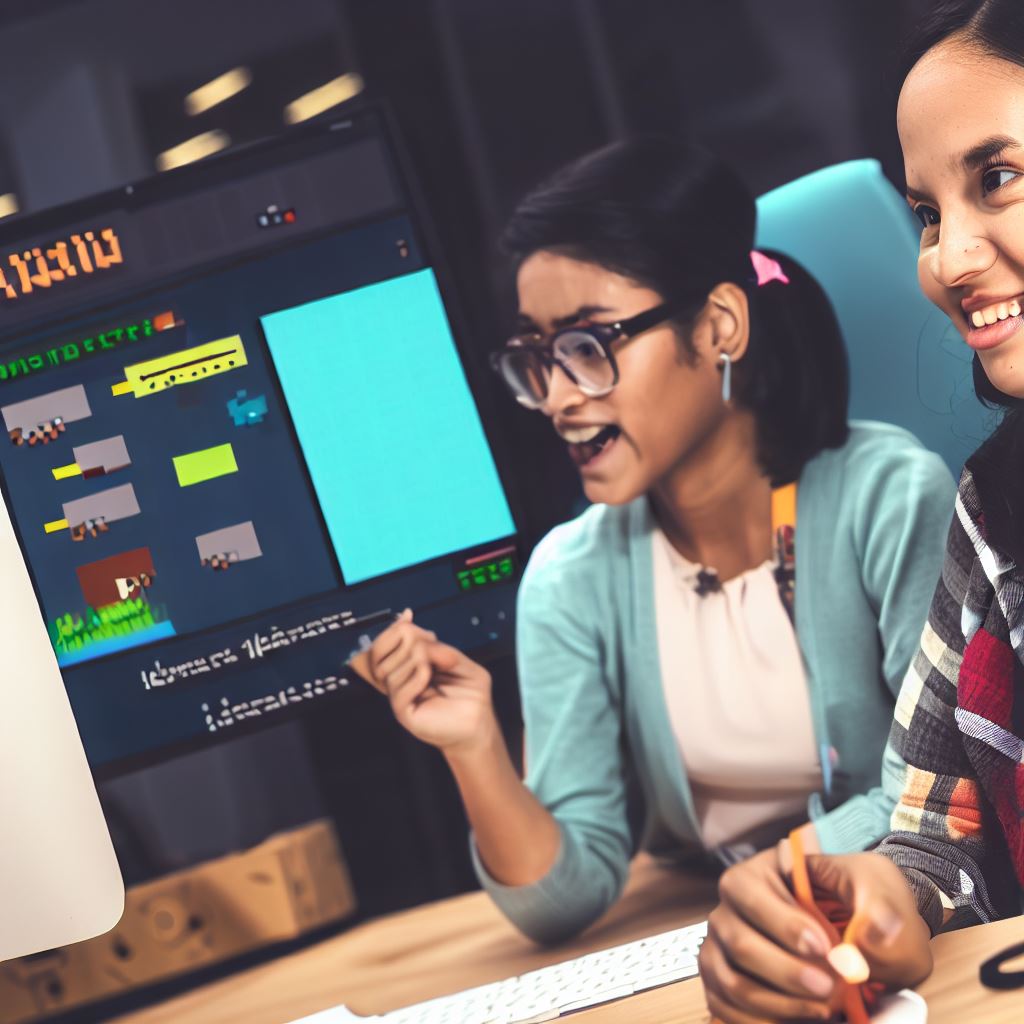Introduction
Minecraft, a hugely popular game with millions of players, has captured the imaginations of gamers worldwide.
One of the key reasons behind its success is the availability of plugins that enhance gameplay.
These plugins allow players to customize their gaming experience, adding new features and functionalities.
In this section, our aim is to teach readers how to code their own Minecraft plugins.
By doing so, players can tap into the immense potential of Minecraft’s modding community and create their own unique gaming experiences.
Plugins are extensions that enable players to modify and add new elements to the game. They can range from simple tweaks to complex features that completely transform the gameplay.
Plugins are vital as they offer endless possibilities for creating personalized adventures in Minecraft
To start coding your own Minecraft plugin, you’ll need a basic understanding of Java programming language. Don’t worry if you’re new to coding; we’ll guide you through the process step-by-step.
Setting up your development environment is essential before diving into plugin coding.
We’ll show you how to install and configure the necessary software, such as the Java Development Kit (JDK) and Integrated Development Environments (IDEs).
Once your development environment is set up, you’ll be ready to write your first Minecraft plugin.
We’ll cover the fundamentals, including creating a basic plugin structure, registering events, and implementing commands.
After coding your plugin, thorough testing is crucial to ensure its functionality. We’ll demonstrate different methods for testing, as well as provide guidance on deploying your plugin to a Minecraft server.
Coding your own Minecraft plugins opens up a whole new world of possibilities. With creativity and coding skills, you can shape your Minecraft experience like never before.
So, let’s embark on this exciting journey together – let’s start coding our own Minecraft plugins!
Tech Consulting Tailored to Your Coding Journey
Get expert guidance in coding with a personalized consultation. Receive unique, actionable insights delivered in 1-3 business days.
Get StartedUnderstanding Minecraft Plugins
Plugins play a crucial role in enhancing the gaming experience of Minecraft players.
They add new features, functionalities, and customization options to the game.
Let’s delve deeper into the world of Minecraft plugins and understand their significance.
A. Definition and purpose of plugins in Minecraft
- Plugins are third-party add-ons that modify and extend the gameplay of Minecraft.
- Their purpose is to enhance the game by introducing new elements, features, and customization options.
- Plugins are created by the Minecraft community using programming languages such as Java.
- These add-ons can range from small tweaks to major modifications, depending on the complexity of the plugin.
B. Types of Minecraft plugins and their functionalities
- Gameplay plugins: These plugins introduce new gameplay mechanics or modify existing ones. They can add new mobs, weapons, tools, or even entire dimensions to explore.
- Economy plugins: These plugins create virtual economies within the game. They introduce currencies, trading systems, and shops, allowing players to buy and sell items.
- Server management plugins: These plugins help server administrators manage their Minecraft servers more efficiently. They provide tools for moderation, anti-griefing measures, and player management.
- Minigame plugins: These plugins add new multiplayer mini-games to Minecraft. They enable players to compete against each other in various challenges and activities.
- World generation plugins: These plugins alter the way Minecraft generates its worlds. They can add new biomes, structures, or customize terrain generation to create unique and diverse landscapes.
C. Importance of plugins in extending the game’s features
- Plugins make Minecraft a more dynamic and immersive experience by adding new content and enhancing existing gameplay mechanics.
- They allow players to tailor their Minecraft experience to their liking, providing a high degree of customization.
- Plugins foster creativity and innovation within the Minecraft community, encouraging players to create unique game modes, challenges, and adventures.
- They enable multiplayer servers to create vibrant communities with their own set of rules and features.
- Plugins offer opportunities for developers to showcase their coding skills and contribute to the Minecraft community.
Minecraft plugins are instrumental in extending the game’s features, enhancing gameplay, and fostering a vibrant community.
With their diverse functionalities and customization options, plugins provide endless possibilities for players to explore and enjoy Minecraft in their unique way.
Whether it’s adding new gameplay mechanics, creating virtual economies, or managing servers effectively, plugins play a crucial role in shaping the Minecraft experience.
So, why not dive into the exciting world of Minecraft plugin development and start coding your own? The possibilities are only limited by your imagination!
Getting Started with Minecraft Plugin Development
A. Overview of the programming languages used for plugin development (Java, Kotlin)
Minecraft plugin development primarily involves two programming languages: Java and Kotlin.
These languages are widely used in the Minecraft community for creating plugins.
B. Installing Java Development Kit (JDK) and Integrated Development Environment (IDE)
Before starting with plugin development, you need to install the Java Development Kit (JDK) and an Integrated Development Environment (IDE) such as Eclipse or IntelliJ IDEA.
C. Setting up Minecraft server for plugin testing
In order to test your plugins, you need to set up a Minecraft server.
This can be done by downloading the Minecraft server software from the official website and following the installation instructions.
D. Familiarization with the Minecraft plugin development environment
Once you have set up the necessary software, it’s important to familiarize yourself with the Minecraft plugin development environment.
This includes understanding the file structure, libraries, and APIs provided by Minecraft.
Build Your Vision, Perfectly Tailored
Get a custom-built website or application that matches your vision and needs. Stand out from the crowd with a solution designed just for you—professional, scalable, and seamless.
Get StartedE. Java and Kotlin: The Languages for Minecraft Plugin Development
Java is the most commonly used programming language for Minecraft plugin development.
It is a powerful and versatile language that offers extensive libraries and tools for plugin creation.
Kotlin, on the other hand, is gaining popularity among plugin developers due to its concise syntax and enhanced features.
It is fully compatible with Java, making it a suitable alternative for Minecraft plugin development.
Both Java and Kotlin provide the necessary tools, libraries, and APIs to interact with Minecraft’s codebase and create custom gameplay features through plugins.
F. Setting up the Development Environment
Once you have installed the Java Development Kit (JDK) and chosen your preferred Integrated Development Environment (IDE), it’s time to set up your development environment for Minecraft plugin creation.
Here are the general steps to set up your development environment:
- Create a new Java or Kotlin project in your IDE.
- Add the Minecraft API or plugin development library to your project’s dependencies.
- Configure your IDE to recognize the Minecraft API or library and provide code auto-completion and error checking.
- Start coding your plugin using the provided API or library.
These steps may vary depending on your chosen IDE, but the general idea is to provide a workspace where you can write, compile, and test your plugins seamlessly.
G. Testing your Plugins: Setting up a Minecraft Server
In order to test your plugins, you need to have a Minecraft server running on your machine.
This can be done by following these steps:
- Download the Minecraft server software from the official website.
- Extract the downloaded files to a dedicated folder on your computer.
- Open the server.properties file and customize the server settings according to your requirements.
- Start the server by running the server executable file.
Once your server is up and running, you can deploy your plugins to the server’s plugins folder and test them by joining the server with a Minecraft client.
Getting started with Minecraft plugin development may seem daunting at first, but with the right tools and knowledge, it can be an enjoyable and rewarding experience.
By familiarizing yourself with the plugin development environment, choosing the appropriate programming language.
And setting up a Minecraft server for testing, you are well on your way to coding your own Minecraft plugins and enhancing your gameplay.
Optimize Your Profile, Get Noticed
Make your resume and LinkedIn stand out to employers with a profile that highlights your technical skills and project experience. Elevate your career with a polished and professional presence.
Get NoticedRemember to continuously learn, experiment, and collaborate with the Minecraft community to expand your plugin development skills and create amazing experiences for yourself and other players.
Read: Node-Webkit: How to Build Native Extensions Effectively
Learning Java Basics
A. Importance of Java in Minecraft plugin development
In order to start coding your own Minecraft plugins, it is important to have a solid foundation in Java programming.
Java is the primary language used for Minecraft plugin development, making it essential to learn its basics.
One of the reasons Java is widely used in Minecraft plugin development is because of its object-oriented nature.
This allows developers to create modular and reusable code, making it easier to develop and maintain plugins.
B. Introduction to Java variables, data types, and operators
When starting with Java, one of the first concepts to understand is variables.
Variables are containers that hold data, and they can have different data types, such as integers, strings, or booleans.
Understanding data types is crucial as it defines the kind of data a variable can hold.
For example, an integer data type can hold whole numbers, while a string data type can hold a sequence of characters.
Operators are another important concept in Java. They are symbols or functions that perform operations on variables or values.
Examples of operators include arithmetic operators (+, -, *, /) and comparison operators (>, <, ==).
C. Understanding control statements (if, for, while) and loops
Control statements, such as if, for, and while, are used to control the flow of a program.
The if statement allows you to execute a block of code if a certain condition is true.
The for and while loops allow you to repeat a block of code multiple times.
D. Exploring object-oriented programming concepts in Java
Object-oriented programming (OOP) is a fundamental concept in Java, and it is crucial to understand it for Minecraft plugin development.
OOP is a programming paradigm that organizes code into objects, which are instances of classes.
In Java, a class is a blueprint for creating objects. It defines the properties and behaviors that an object will have.
By utilizing classes and objects, developers can create plugins that are more efficient and maintainable.
Some important concepts in OOP include inheritance, polymorphism, and encapsulation. Inheritance allows a class to inherit properties and methods from another class, reducing code duplication.
Polymorphism allows objects to take on multiple forms and behave differently based on their class hierarchy.
Encapsulation helps protect data by keeping it private and providing controlled access through methods.
By familiarizing yourself with these key concepts in Java programming, you will be well-equipped to start coding your own Minecraft plugins.
In essence, Java is essential for Minecraft plugin development due to its object-oriented nature.
Learning the basics of Java, such as variables, data types, operators, control statements, and object-oriented programming concepts, is crucial for creating functional and efficient plugins.
Read: The Evolution of Coding Hours in the Past Decade
Introduction to Minecraft API and Bukkit
In this section, we will explore the Minecraft API and the role of the Bukkit framework in Minecraft plugin development.
We will also familiarize ourselves with essential Bukkit classes and methods.
A. Explanation of Minecraft API
The Minecraft API, or Application Programming Interface, is a set of rules and protocols that allow developers to interact with the game and modify its behavior.
It provides a way to access and manipulate various aspects of the game, such as player data, world generation, and item management.
- The Minecraft API is crucial for creating plugins that extend the game’s functionality.
- It allows developers to tap into the game’s code and use it as a foundation for their own creations.
- By using the Minecraft API, developers can design custom features, add new gameplay mechanics, and enhance the overall gaming experience.
B. Bukkit Framework and its Role in Minecraft Plugin Development
Bukkit is a popular open-source framework for creating plugins for Minecraft.
It is built on top of the Minecraft API and provides a powerful set of tools and utilities for plugin development.
- Bukkit simplifies the process of creating plugins by providing a framework that handles common tasks and routines.
- It offers an extensive set of classes and methods that plugin developers can utilize to interact with the game.
- Bukkit also provides a plugin architecture that allows developers to easily add, remove, and manage plugins within a Minecraft server.
- The framework handles crucial aspects such as event handling, command execution, and persistence of plugin data.
- Overall, Bukkit streamlines the plugin development process and enables developers to focus on implementing their ideas rather than dealing with low-level mechanics.
C. Familiarization with Essential Bukkit Classes and Methods
In order to start coding our own Minecraft plugins, it is crucial to become familiar with essential Bukkit classes and methods that we will be using during the development process.
- The
org.bukkit.plugin.java.JavaPluginclass is the base class for all Bukkit plugins and provides essential methods for initialization and termination. - The
org.bukkit.event.Listenerinterface is used to handle events triggered by the game, such as player interactions or world changes. - Bukkit provides a wide range of event classes that extend the
org.bukkit.event.Eventclass, representing different types of in-game events. - Methods like
onEnable()andonDisable()can be overridden to perform specific tasks when the plugin is enabled or disabled, respectively. - Bukkit also offers various utility classes for tasks like scheduling delayed or repeated tasks, logging messages, and interacting with player inventories.
By becoming familiar with these essential Bukkit classes and methods, we will have a solid foundation for coding our own Minecraft plugins.
In the upcoming sections, we will dive deeper into plugin development and explore advanced topics and techniques.
Read: Studies on Optimal Coding Hours for Maximum Efficiency

Creating Your First Minecraft Plugin
Are you ready to dive into the exciting world of Minecraft plugin development?
In this section, we will walk you through the steps of creating your first Minecraft plugin from scratch.
Let’s get started!
A. Setting up a new plugin project in IDE
- Launch your Integrated Development Environment (IDE) and create a new project.
- Select the option to create a new Maven project if available.
- Specify the necessary details such as Group Id, Artifact Id, and version, then click “Finish”.
B. Creating a basic plugin structure
- Navigate to the project’s root folder using your IDE’s file explorer.
- Create a new directory called “src” inside the project’s root folder.
- Inside the “src” directory, create two more directories: “main” and “resources”.
- In the “main” directory, create another directory called “java”.
- Move into the “java” directory and create the main package structure for your plugin. For example, “com.yourname.pluginname”.
C. Defining plugin metadata and dependencies
- Create a new Java class inside the main package, naming it after your plugin.
- Add the necessary plugin annotations, such as
@Plugin, to your class. - Define the plugin’s metadata, including its name, version, author, and description.
- Specify any required dependencies by adding
@Dependencyannotations.
D. Implementing event listeners and handling events
- Create a new Java class inside the main package, naming it something like “EventListener”.
- Implement the appropriate event listener interfaces, such as
Listener, provided by the Minecraft API. - Add the event handlers for the events you wish to listen to inside this class.
- Implement the necessary logic to handle each event according to your plugin’s functionality.
And that’s it! You have now created your first Minecraft plugin. Remember to save all your changes and build the project to generate the plugin’s JAR file.
After building the project, you can now copy the generated JAR file into the “plugins” directory of your Minecraft server.
Start or restart the server to load your plugin, and voila, you’ll be able to see your plugin in action in the game!
Creating your own Minecraft plugin is an exciting learning experience that allows you to unleash your creativity and add new features to the game.
With practice and further exploration of the Minecraft API, you can expand your plugin’s functionality and make it even more robust.
Now that you have completed your first plugin, the possibilities are endless.
Go ahead and experiment with different event listeners, explore new Minecraft APIs, and create plugins that will surprise and delight Minecraft players around the world!
Read: The Rise of AI: Coding Websites That Teach Machine Learning
Adding Functionality to Your Plugin
Implementing commands for customized gameplay:
- Commands are powerful tools that allow players to interact with your plugin.
- Use the Bukkit API to register and handle custom commands within your plugin.
- Create command classes that extend the Bukkit CommandExecutor interface and override the onCommand method.
- Use the CommandSender object to differentiate between console and player usage.
- Parse command arguments and provide appropriate feedback to players using the sender.sendMessage method.
- Leverage the Bukkit API to execute gameplay changes based on the command input received.
A. Manipulating game elements using Bukkit API
- The Bukkit API provides numerous classes and methods to manipulate the game world.
- Access and modify game elements such as blocks, entities, and inventories.
- Use the Block object to set block types, trigger events, and interact with neighboring blocks.
- Access and modify entity attributes like health, movement, and AI using the Entity framework.
- Utilize the Inventory class to manage player inventories and create custom item interactions.
- Take advantage of event listeners to listen for game events, such as player interactions or block changes.
B. Creating custom items and blocks
- Enhance your gameplay experience by adding custom items and blocks to your plugin.
- Extend the ItemStack class to create unique item types with custom behavior and attributes.
- Use the Material enum to specify the desired block or item type.
- Customize block and item properties such as durability, enchantability, and transparency.
- Implement custom interactions and effects using the ItemStack events provided by the Bukkit API.
- Register your custom items and blocks with the server to make them available in-game.
C. Developing in-game GUIs and menus
- GUIs (Graphical User Interfaces) and menus provide visual interfaces for players to interact with your plugin.
- Use libraries such as Bukkit’s Inventory API to create user-friendly GUIs.
- Design GUI layouts using inventory slots and ItemStack objects representing buttons or options.
- Handle player interactions with GUIs using event listeners and inventory click events.
- Implement logic to process player input and update the GUI accordingly.
- Utilize NBT tags or custom inventory metadata to store additional custom data for GUI interactions.
By adding functionality to your plugin, you can create a richer and more engaging gameplay experience for Minecraft players.
From implementing commands for customized gameplay to manipulating game elements using the Bukkit API, the possibilities are endless.
Creating custom items and blocks adds uniqueness, while developing in-game GUIs and menus enhances player interaction. With each added feature, your plugin becomes more powerful and captivating.
So, let your creativity soar and start coding your own Minecraft plugin now!
Read: Best Coding Websites for Women in Tech: A Close Look
Testing and Debugging Your Minecraft Plugin
A. Testing the plugin on a local server
- Set up a local Minecraft server environment to test your plugin.
- Install your plugin on the server and restart it to ensure proper loading.
- Join the server with a test account to simulate real gameplay and interactions.
- Interact with the plugin’s features to verify its functionality and compatibility.
- Test the plugin under different scenarios and conditions to ensure robustness.
B. Troubleshooting common plugin errors and bugs
- Identify and understand common errors and bugs that can occur in Minecraft plugins.
- Monitor server logs and console output for any error messages related to your plugin.
- Check for compatibility issues with other plugins or server versions.
- Use online resources and forums to search for possible solutions to common plugin problems.
- Take note of any recurring issues and explore potential fixes or workarounds.
C. Utilizing debugging tools and techniques
- Familiarize yourself with debugging tools available for Minecraft plugin development.
- Enable debugging features in your Integrated Development Environment (IDE) or code editor.
- Utilize logging mechanisms to track important program information and variable values.
- Implement breakpoints strategically to pause the plugin’s execution for inspection.
- Step through the code incrementally, examining variables and logic flow to identify issues.
D. Gathering feedback and improving the plugin
- Encourage players and fellow developers to provide feedback on your plugin.
- Create a platform for users to report any bugs, glitches, or suggestions they encounter.
- Actively engage with the community, addressing concerns and acknowledging feedback.
- Regularly update and enhance your plugin based on the received feedback.
- Continuously test and review the plugin to ensure it remains functional and up-to-date.
By following these testing and debugging practices, you can ensure the quality and stability of your Minecraft plugin.
Remember that thorough testing and prompt bug fixing are essential for a positive user experience.
Sharing and Publishing Your Minecraft Plugin
In order to make your Minecraft plugin available to others, you need to package it for distribution.
Once packaged, you can choose a suitable platform to share it with the Minecraft community.
A. Packaging the Plugin for Distribution
- Organize the files and resources of your plugin into a single folder.
- Create a plugin description file, commonly named plugin.yml, which includes important information like plugin name, version, author, dependencies, etc.
- Add any required libraries or dependencies to your plugin folder.
- Compress the plugin folder into a .zip or .jar file, ready for distribution.
B. Choosing a Suitable Platform to Share the Plugin
- Minecraft forums: Post your plugin on popular Minecraft forums to reach a wide audience.
- Spigot: Share your plugin on Spigot, a popular platform specifically for Minecraft plugins and server customization.
- Bukkit: Another platform dedicated to Minecraft plugins, with a large user base and active community.
- Curseforge: The official plugin repository of Minecraft, offering a trusted and reliable platform for publishing plugins.
C. Documenting the Plugin’s Features and Instructions for Users
- Create a README file that provides a brief overview of your plugin, its features, and how to use it.
- Include clear and concise instructions on how to install and configure the plugin.
- Add any additional documentation or FAQ sections to help users troubleshoot common issues.
D. Engaging with the Minecraft Plugin Development Community
- Join online forums and communities dedicated to Minecraft plugin development.
- Participate in discussions, ask questions, and share your knowledge with others.
- Provide support and respond to user feedback or bug reports promptly.
- Collaborate with other developers on projects or contribute to open-source plugins.
- Regularly update and improve your plugin based on user feedback and emerging trends.
Sharing and publishing your Minecraft plugin is an exciting step that allows your creation to be enjoyed by others.
By packaging it properly, choosing the right platform, documenting its features, and engaging with the community, you can ensure a successful release and foster a growing user base.
Conclusion
This section has highlighted the main points of Minecraft plugin development. We have discussed the importance of learning coding to create your own plugins.
By taking this step, you open up endless possibilities for enhancing your Minecraft gameplay.
I encourage all readers to start coding their own Minecraft plugins. It may seem daunting at first, but with patience and practice, you can become proficient in plugin development.
The Minecraft community is welcoming and supportive, providing resources to help you along the way.
Remember, the possibilities are truly endless when it comes to plugin development. You can create unique gameplay experiences, add new features, and customize Minecraft to fit your vision.
The satisfaction and fulfillment that come from seeing your creations come to life are unmatched.
So, don’t hesitate any longer. Start coding your own Minecraft plugins today and unlock a whole new world of creativity and innovation.
Whether you’re a seasoned coder or a beginner, there’s no better time to dive into the exciting realm of plugin development.
Embrace the challenges, embrace the possibilities, and let your imagination run wild. The Minecraft community awaits your creations.




